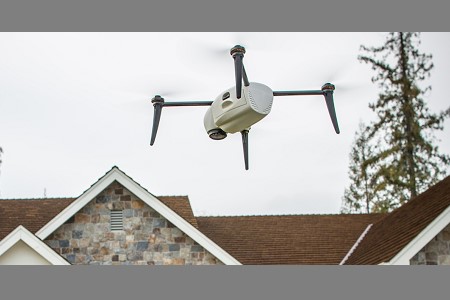

Drones are no longer just cameras in the sky. They’re autonomous, artificially intelligent flying machines with the ability to capture sharp resolution of an asset and use machine learning to process data through analytical models.
But all of that potential is constantly challenged by regulation.
Farmers Insurance is one of the big industry names to enlist a fleet of unmanned aerial aircraft systems (UAS) produced by Kespry, with the aim of enhancing the claims adjusting experience, particularly when assessing roof damages, for both customers and staff.
Generally speaking, Farmers Insurance has received “positive feedback” and is pleased with the progress of its “aerial imagery strategy,” according to Farmers Insurance head of property claims, Tim Felks. However, there was one scenario where its fleet of drones fell short of its potential.
“Last year, we discovered that wind claims coming off the back of a hurricane are not the best use-case to deploy drones,” Felks told Insurance Business. “We deployed our drones after the hurricanes, but by the time air restrictions were lifted, most roofs were already tarped, so all the drones were able to do is get some pretty pictures of tarps on roofs. In most cases, we had to get somebody up on the roof to do a physical assessment.”
However, the restrictive airspace situation is changing thanks to the Federal Aviation Administration’s (FAA) rolling out of the new Low Altitude Authorization and Notification Capability (LAANC) program. In the past, the FAA often declared emergency airspace during catastrophe events to prevent any potential airspace interference with emergency and rescue operations. Drone pilots had to apply for authorization from the FAA, which could take up to 90 days to go through.
The LAANC program gives drone pilots access to controlled airspace through instant processing of authorizations below approved altitudes. Drone operators can process an application for airspace authorization within minutes through a number of apps, including the Kespry app, that are linked to the program.
“The regulatory landscape is continuing to evolve in the right direction for drone operators,” said Kespry CEO George Mathew. “If you read between the lines for the use-case of drones after hurricanes, the challenges last season weren’t necessarily technical. The main issue was that there were temporary flight restrictions (TFR) in place that prevented anybody who wasn’t a government agency from flying in certain areas. By the time the TFRs were lifted, tarps had already been placed on most of the roofs.
“With LAANC integration, drone operators are able to automate the waiver process with the push of a button. We’re incorporating that capability directly into the Kespry flight planning systems, so that an adjuster on the ground near a restricted area can push a button inside the Kespry app and get a flight waiver processed as soon as possible.”
Government agencies like the Federal Emergency Management Agency (FEMA) seem to be showing support for more regulatory openness around flight restrictions to help with catastrophe response, Mathew added.
“They’ve seen how technology can serve the right outcomes for storm-impacted regions, and can see the value of gaining much-needed analytics and information quickly and efficiently,” he said.
